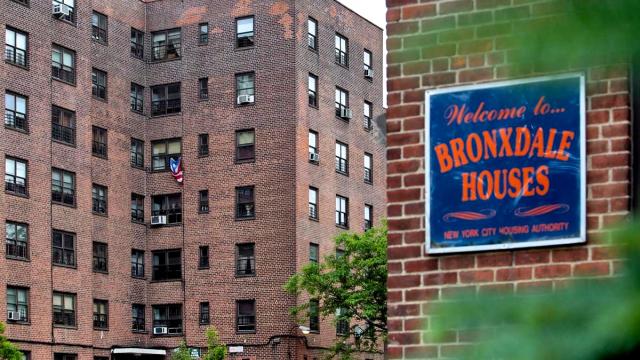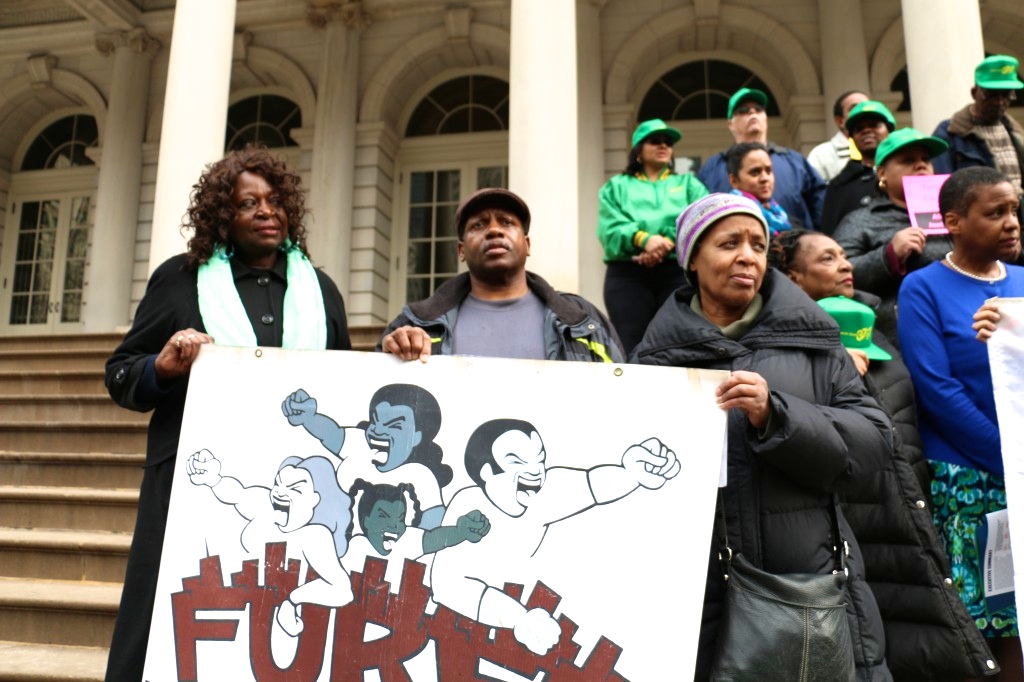
The poster child for the foreclosure crisis has been a middle-income suburban family. But low-income urban renters also saw their buildings over-mortgaged at the height of the crisis, and now faceless hedge funds and nameless investors are replacing their desperate landlords — sometimes with disastrous consequences.
Six years after the foreclosure crisis helped tank the world’s economy, investors are snatching up “distressed” properties — those that are in foreclosure or facing foreclosure — and seeking to turn a profit on them. Advocates for affordable housing worry that this profit comes at the expense of tenants.
Joanna Paulino knows this all too well. She lives in a lower-income neighborhood in the Bronx borough of New York City. Her home is a prewar building, a once attractive structure like many others in the city’s outer boroughs. But after years of neglect, it is crumbling; there are more than 140 violations registered against the premises.
Paulino tried for years to get her landlord to fix the cracked floor tiles, the faulty electrical wiring, the mold that seems to grow from the walls and that she suspects makes her children ill. But recently, she hasn’t known whom to contact. Responsibility for her building was handed off between the landlord who owned it when she moved in, the bank he was indebted to, the private equity fund that bought his debt from his bank, and the real estate holding company that currently owns the mortgage.
“If I had the money I would move,” Paulino said. “But I don’t have the money. This is what I have, so this is what I will fight for.”
Over the last several months, Wall Street firms have snapped up an estimated 200,000 single-family homes with the intention of renting them out. The New York–based hedge fund Blackstone Group is now America’s largest landlord of rental homes after purchasing over 40,000 foreclosed single-family homes in 14 metro areas around the country, from Atlanta to Phoenix, to convert into rental properties.
But certain investors are also snatching up “distressed” urban rental buildings like the one where Paulino lives in the South Bronx. Unbeknownst to many low-income renters, their buildings were over-mortgaged during the bubble. In New York, many of those buildings are due for refinancing now — making them vulnerable to acquisition by hedge funds.
“Since these buildings are so over-mortgaged,” said Harold Shultz, an affordable-housing expert who works with the Citizens Housing Planning Council of New York, “the likelihood is that they are not going to be able to be refinanced.”
Desperate landlords and banks are looking for new owners and investors. And Wall Street is ready to step in and help out.
These groups often purchase buildings sight unseen, with little knowledge of the conditions a foreclosed building might be in. Sometimes, especially in the case of apartments, foreclosures can take years to resolve.
So while old owners, banks and new owners or investors sort out the debt, buildings languish in disrepair. And when an agreement is eventually reached, there is no guarantee for tenants that conditions will improve.
Overstretched
Paulino’s building was purchased before the housing crisis came to a head. The former owner, Asher Neuman, was able to secure a series of massive loans, even though he had no prior experience with property management. According to city records, he spent $1.9 million for his new building, even though the property was appraised as worth only $223,000.
“I thought this would be a side business,” said Neuman. “The guy who sold the building, I trusted him. I knew he was in the industry of owning buildings like this. I didn't look into the details. I didn't realize how bad it was.”
The building proved a nightmare to manage. As the number of violations continued to increase, so did the cost of maintenance. By 2012, Neuman was in charge of a building that was not only falling apart but also half empty, as tenants moved out seeking better living conditions. Eventually, he was unable to make mortgage payments and declared his real estate holding company bankrupt.
Enter Stabilis Capital Management, a private equity firm financed by some of New York’s investing elite. The fund purchased the mortgage from Neuman’s bank without first inspecting the building.
“Lenders in the secondary market are generally not permitted to contact a borrower on a loan prior to a loan being transferred, and a secondary market lender is not given access to a building as would be the case in a normal property sale,” Stabilis said in an email statement. “So to the extent that there are alleged issues with the condition of the property, a lender in the secondary market would generally not be in a position to know of such issues prior to becoming the successor lender.”
Stabilis is not the only firm in the distressed New York real estate game. Madison Realty Capital, Onex Real Estate Partners and Waterfall Victoria Master Fund are also major players that have attracted tenant advocates’ attention.
“The figure for the portfolios that we actively track is upwards of $5 billion in this kind of investment in New York,” said Celia Weaver, an organizer with the Urban Homesteading Assistance Board (UHAB), an advocacy group that tracks distressed debt players in the city. “But the actual number is likely much, much larger.”
This is because, Weaver said, equity investors are seeking to control the properties through mortgage notes — or debt — rather than deeds. The price paid for mortgages is not recorded in public databases, and banks are reluctant to disclose any information about such sales.
According to documents filed at the Office of the City Register, Stabilis bought mortgages on dozens of buildings in poor condition across the city over the past three years. At one point last summer, six buildings on which Stabilis held mortgages in the borough of Queens had 550 housing violations on 36 apartments.
“We cannot continue to live like this. Our neighbors and children suffer from asthma, which is only worsened by the rats and mold,” tenants of the buildings wrote in a letter to the private equity firm, urging its managing members to sell the buildings to a city-approved affordable-housing developer. Another letter, from a group of tenants in Ridgewood, Queens, stated, “One of our members is suffering from cancer and associated chemotherapy treatments; the conditions in our homes threaten her weakened immune system.”
Stabilis Capital Management is headquartered in the General Motors building, an iconic skyscraper that sits on the southeast corner of Manhattan’s Central Park — and within 10 miles of many of the low-income neighborhoods where the tenants live. The firm was founded and, in part, funded by activist investor Timothy Barakett. At the top of his game, Barakett had a personal net worth said to be about $2 billion. With the help of Nathaniel Rothschild, in 10 years Barakett built up Atticus Capital, the hedge fund for which he is best known, from $6 million to almost $20 billion.
But in 2008, the stock market crashed and the U.S. arm of Atticus Capital lost 27 percent of its value in just eight months, and kept plummeting. In 2009, Barakett walked away, describing his decision in a letter to investors as “an opportunity to spend more time with my family, pursue my philanthropic interests and establish a family office to manage my own capital and charitable foundation.”
Five years later, Barakett has reinvented himself. As a philanthropist he’s donated millions through the private foundation he runs with his wife, including at least $125,000 in 2012 to the Robin Hood Foundation, a popular Wall Street charity dedicated to helping New York’s poor. Professionally, his funds have become major purchasers of distressed commercial real estate debt.
‘Don’t Know Where We Stand’
Advocates for tenants worry about hedge fund and private equity firms’ intentions when they invest in distressed affordable housing in New York.
“These companies need to get certain returns on their investments, and when they’re investing in rent-stabilized housing, the only way to get the returns needed is through predatory tactics: reduced services, manipulating rent laws, forcing long-term tenants out to raise rents, etcetera,” said Elise Goldin, a tenant organizer with UHAB. “If a company is investing in a hotel in Manhattan, the results are much different — no one’s lives are impacted in the attempts to get the financial return.”
A spokesperson for Stabilis said the fund’s intention is to improve the buildings and pass them on to a new owner.
“Improving these assets is critical to improving the value and allowing a lender to recover the debt that is owed to it,” Stabilis said in an emailed statement. “We have been and remain committed to ensuring that buildings are brought up to code and tenants’ living situations are improved — always.”
The fund said it spent “tens of thousands of dollars on, among other things, clean up and utilities” in the building where Paulino lives.
But Paulino said her living environment continued to deteriorate even after Stabilis became the lender. One night in the summer of 2012 she woke up at 3 a.m. to the smell of smoke. She said her ceiling had caught fire. Neuman, the former landlord who paid for the repairs, confirmed aging electrical wiring was to blame for the smoke.
“It wasn’t really a fire,” Neuman qualified it. “It was just a black ceiling.”
Paulino spent many sleepless nights worrying that it was only a matter of time before another fire would erupt.
According to city documents, Stabilis sold the mortgage to FCA Realty Holding LLC, a group that turns many of its apartments into housing for homeless people, in December 2013. FCA managers met with UHAB and tenants of Paulino’s building and said there were no immediate plans to turn the building into a so-called cluster-site shelter — a program through which landlords are paid by the city and nonprofit agencies to house homeless people — but with many rooms vacant, tenants are not reassured.
“We spent years in limbo,” Paulino said. “Even today, we basically don’t know where we stand. I’m willing to go to every meeting, to do everything that is possible to get my home to where I want to get it.”
3 WAYS TO SHOW YOUR SUPPORT
- Log in to post comments

















